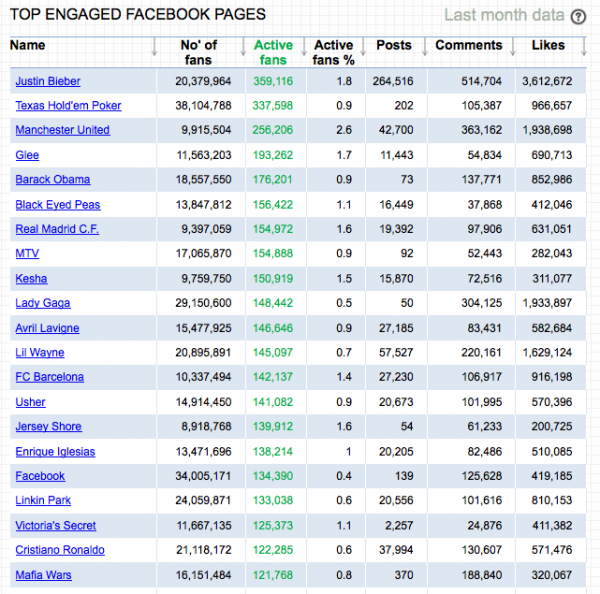von Roland Hachmann | Mrz 18, 2011 | Blog, Digital Marketing, Social Media Marketing
You think „Fans“ on facebook, i.e. people liking your brand’s facebook page, are a useful currency for measuring success on the social web? Well, think again.
(First: the social web is more than just facebook.)
The number of fans is not a very relevant social web KPI, if they’re not active at least some of the time. Inactive fans might have shown some interest when „liking“ the facebook page. However, a large amount of inactive fans shows, that after an initial „liking“, engagement by the brand wasn’t very successful.
Hence, there is list of „top engaged facebook pages“ on facebook compiled by FanGager.
The idea: forget about the ranking of brand pages on facebook by „fans“, instead rank them by „active fans“. Nice approach, but when comparing success on facebook, I think the percentage of active fans is a much more valuable figure to measure engagement.
Popular brands will always have a larger fanbase and hence are more likely to have a larger base of active fans, too. But brands with fewer fans but a higher percentage of active fans seem to doing a much better job on facebook. (Alternatively: they are much more engaging brands to start with.)
The full list can be viewed here. Here is a screenshot of the top listed pages:

von Roland Hachmann | Dez 12, 2006 | Blog, Digital Culture, Marketing Trends, Social Media Marketing
Steve blogging as the Creative Generalist had a brilliant idea some time ago:
A university pal and I made a pact upon graduation. The deal was that we would venture out into the world and build our careers but that one day we would meet up again and start our own university program, a Faculty of Everything. A paradise for curious generalist learners. Ideally, such a „school“ would be:1. Random – From the banal to the offensive to the foreign to the ridiculous, everything and anything is interesting.
2. Surprising – Each class would teach something new and completely unexpected.
3. Involving – A big part of learning is doing, so participation is a must.
4. Moving – Break free of the classroom to wander, explore and travel.
5. Inviting – Not unlike the popular idea conference format, guest presenters would be plentiful and varied.
6. Intersectional – Ideas and teachers from disparate disciplines bump into each other.
7. Multi-generational – Kids, adults, and elders together.
8. Multicultural – A mix of worldviews.
9. Playful
10. Never-ending – The semester would never end. There would be no final degree. Just a journey.
I’ll join anytime. Let me know when you start 😉
von Roland Hachmann | Nov 25, 2006 | Ad News, Blog, Digital Marketing, Digital News, Mobile Marketing, Online Advertising
Robert Passikoff writes about seven brand and marketing trends for 2007
He starts of with a nice quote:
Nobel Prize winner Niels Bohr once noted that “prediction is very difficult, especially about the future,�
And then continues pitching his company USP:
but then he didn’t have access to predictive loyalty metrics. Happily, we at Brand Keys do.
The 7 trends are (*drumroll here*):
- An ongoing emphasis on “engagement.�
- More reliance on consumer-generated content.
- More, more branded entertainment.
- Media planning will become more “touch point� focused.
- Using technology and engagement to better communicate with consumer expectations.
- Expanding the potential of Websites, blogs, and the digital world.
- Innovation and loyalty will matter more.
Sounds good. But there is nothing really new in this. The only difference being, that these trends will probably now reach a certain visibility among marketers so that we’ll see a lot more campaigns, tactics, etc. around these 7 points. I am certainly looking forward to that.


 Wo ich sonst so bin...
Wo ich sonst so bin...